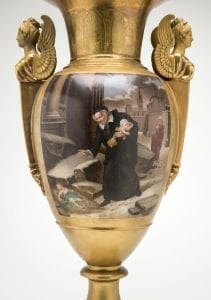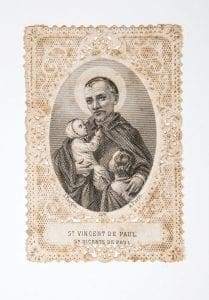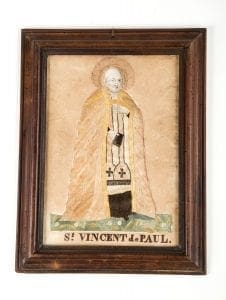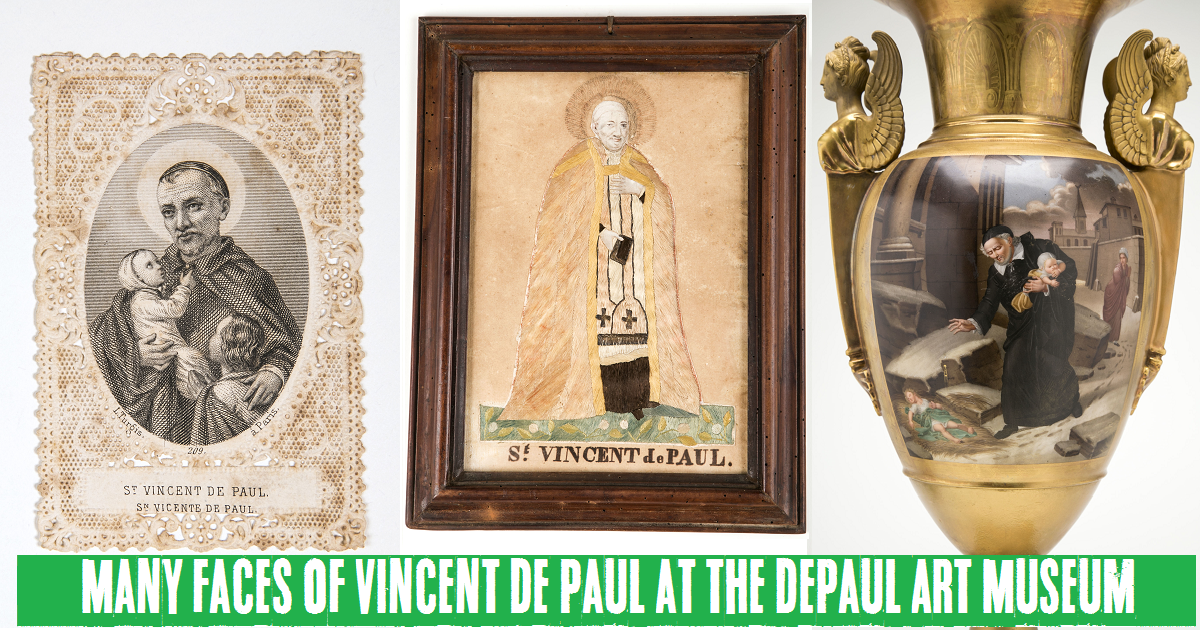DePaul Art Museum will offer two winter exhibitions, “Four Saints in Three Acts” and “The Many Faces of Vincent de Paul: Nineteenth-Century French Romanticism and the Sacred.” Both exhibitions open Jan. 26 and run through April 2.
“Four Saints in Three Acts,” will feature works by contemporary artists who use religious imagery to consider their own relationship to religion, belief and faith. “The Many Faces of Vincent de Paul: Nineteenth-Century French Romanticism and the Sacred,” will examine how artists depicted DePaul University’s patron saint in material culture and decorative arts. “St. Vincent de Paul’s life and work drive the mission of the university and museum. These exhibitions will help us explore his legacy as an advocate for the poor and for what we know today as social justice,” said Julie Rodrigues Widholm, the museum’s director and chief curator.
Admission is free at DePaul Art Museum, located at 935 W. Fullerton, just east of the CTA’s Fullerton ‘L’ stop. Museum hours are Wednesdays and Thursdays from 11 a.m. to 7 p.m., Fridays from 11 a.m. to 5 p.m., and Saturdays and Sundays from noon to 5 p.m. The museum is closed Mondays and Tuesdays. For more on DePaul Art Museum’s upcoming exhibitions and events, call 773-325-7506 or click here.

A gilded urn from the mid-19th century pictures St. Vincent de Paul rescuing abandoned children from snowy streets. The item is from DePaul University’s collection and is part of a special exhibition, “The Many Faces of St. Vincent de Paul: Nineteenth-Century French Romanticism and the Sacred,” at the DePaul Art Museum. (DePaul University/Jamie Moncrief)

A holy card shows St. Vincent de Paul with a halo, holding an infant. These small, inexpensive images made devotional art accessible to the masses during the 19th century. The item is from DePaul University’s collection and is part of a special exhibition, “The Many Faces of St. Vincent de Paul: Nineteenth-Century French Romanticism and the Sacred,” at the DePaul Art Museum. (DePaul University/Jamie Moncrief)

A rustic, hand-embroidered portrait of St. Vincent de Paul is an example of the 19th-century craft, often practiced by young girls to improve their sewing skills. The item is from DePaul University’s collection and is part of a special exhibition, “The Many Faces of St. Vincent de Paul: Nineteenth-Century French Romanticism and the Sacred,” at the DePaul Art Museum. (DePaul University/Jamie Moncrief)
Photos and captions provided by: Kristin Claes Mathews, kristin.mathews@depaul.edu, 312-362-7735
More about “The Many Faces of Vincent de Paul: Nineteenth-Century French Romanticism and the Sacred”
Long before pop stars inspired T-shirts and trinkets, St. Vincent de Paul’s devoted followers were clamoring for items in his image. In “The Many Faces of Vincent de Paul: Nineteenth-Century French Romanticism and the Sacred,” guest curator the Rev. Edward R. Udovic, C.M., gathers items from DePaul University’s collection that reflect the rise of Vincent’s popularity.
“During his lifetime, Vincent was a controversial figure and a classic church reformer. After the French Revolution, that was all history,” said Udovic, a professor of history and senior executive for university mission.
In the 19th century there was a refounding of the Vincentian order, and the French “reinterpreted Vincent in a very romantic, heroic way,” said Udovic. Instead of being pictured as an evangelizer, artists began depicting St. Vincent holding and rescuing children. “One baby was good, two babies were better and three babies were great,” said Udovic. He explained that this shift mirrors France’s movement toward a more secular society, and St. Vincent was venerated as the “apostle of charity.”
This makeover of St. Vincent’s image coincided with industrialization and the emergence of the middle class, so devotional items made in his image became more accessible, explained Udovic. “There were all kinds of holy cards and statues. In just the sheer scale and scope, it was an explosion,” said Udovic.
He added that “Vincent is by far the most popular 19th century French saint. Figures of him outnumber everyone else’s by a wide margin. He was marketable because what he represented was marketable.”
DePaul University holds the world’s largest collection of material culture related to St. Vincent de Paul. Artifacts on display from the university’s collection reflect the varying quality and artistry of devotional items from the period, said Udovic.
Today, Udovic and other Vincentian historians are interested in examining what is fact and what is fiction in artistic depictions of St. Vincent. “You can look at the thousands of images of St. Vincent de Paul and see the themes — artists who are trying to uncover a universal truth,” he said.
Source: DePaul Newsroom








Great exhibit. Saw it Sunday with 2 other SCs. The guidebook is very helpful too.